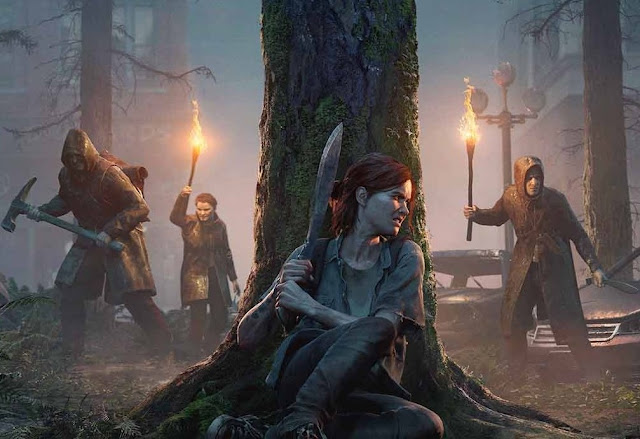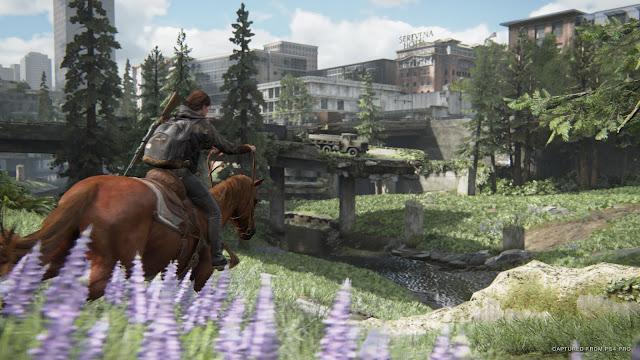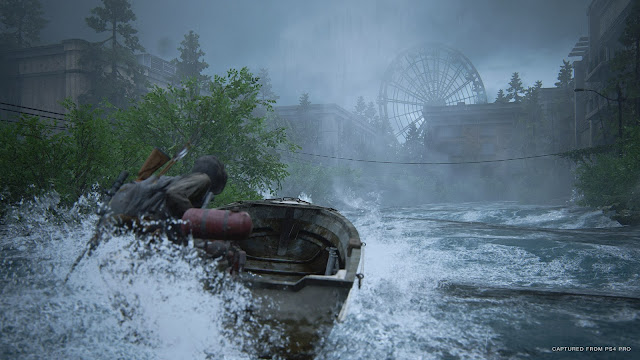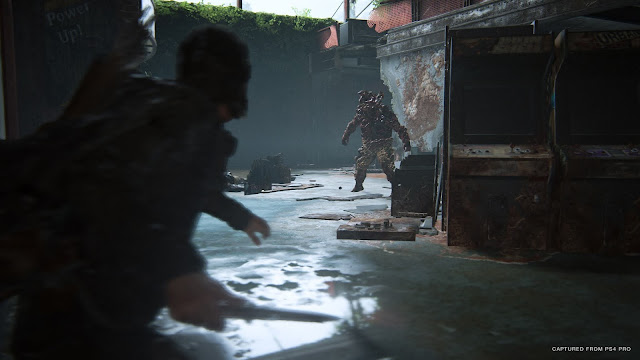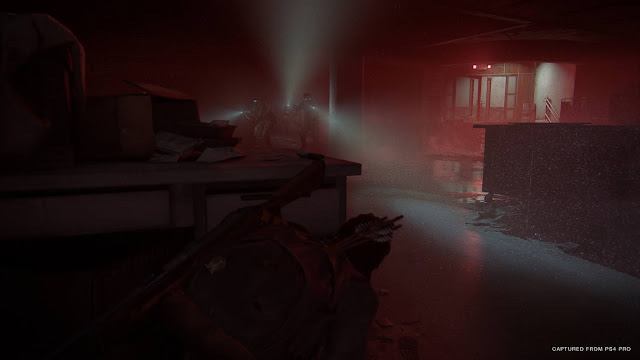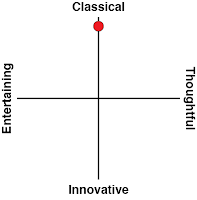Review by Matt S.
The Last of Us Part II is a difficult game to review. That’s not to say that there isn’t anything worth talking about in it, because there is a lot, but rather the difficulty comes from an extended list of embargo conditions that make it impossible to discuss the narrative of this narrative-driven game on any meaningful level. To discuss narrative, you need to be able to drill down into specific examples that highlight key themes and narrative beats, and any specifics that I might want to discuss that highlight how this game engages with its themes I simply can’t mention. So, I have a choice; either I don’t discuss the narrative at all, or I do so in such vague and meaningless terms that any criticism I might have is impossible to substantiate and therefore easy to dismiss.
I’ll prove it to you by sharing some analysis of the first half of the game while being mindful of these “spoilers.” Neil Druckmann, the lead creative behind this game, is one of those maddingly poor writers that mistakes emotional manipulation for intellectual depth. You’ll come away from his game feeling things for sure, but as far as philosophy goes, the whole experience is almost painfully shallow and juvenile. Druckmann’s vision is a yearning for the American Wild West as equivalent to the American Dream, in which small and insular communities band together with minimal legal or government involvement. What’s more, these communities are presented as inherently free of the human nastiness that we see in more nuanced Westerns that do challenge the idea that this state of living is utopic. It’s only when hostile forces from without threaten the gleefully free and anarchistic Wild West that Druckmann’s world is allowed to become anything but a kind of woksey “simpler times,” in which kids throw snowballs around, teenagers and young adults indulge in drugs and free humping, and people are more concerned with accepting a sandwich from a bigot than they are with actually eating.
You contrast this with a show like Deadwood or a film like The Good, The Bad, And Ugly, which highlight the moral conflicts of living this kind of freedom (and are decidedly pragmatic about just how woke these kinds of societies really are when unburdened from the social contract and the law), and The Last Of Us Part II comes across as dangerously naive. That’s not to say the game doesn’t recognise the violence of such a setting, because, as I mentioned, there are threats from without, and there are “zombies”, but because everyone is armed to the teeth and nonchalant about the guns they carry around, no one seems particularly concerned by these things either. Certainly not enough to let it get in the way of their free sex and drugs. Nor do the supposedly persistent threats to the utopia prevent individuals from going on wide-ranging missions for revenge, damned the consequences to anyone around them or those they leave behind. Being frank here, the entire concept of The Last Of Us Part II, the kind of people that it lionises, and the setting itself come across as a vision of a utopia dangerously close to matching up what you’d expect to see in prepper or NRA propaganda.
All of the above is absolutely true in my read of this game, and yet I can’t substantiate a single word of it without delving into “spoilers.” To try and go further with the analysis of the narrative would be to provide poor, unsubstantiated criticism, since I’d be leaving you with more questions and holes than I’m able to fill, and I’d certainly be unable to defend my position via narrative evidence. If I was a betting man I would even be inclined to throw the dice at the idea that the embargo conditions are there precisely because Sony is aware that down the track the discussion on The Last Of Us Part II will transition to a deconstruction of its failings as a narrative. But, with all of the above as context, because we can’t discuss the narrative here, we’re not going to in this review. Instead, we’re going to talk about the gameplay. This is why you’ll see the score that you do at the bottom, because it really is that good, but I felt it important that you read the remainder of the review fully aware that I just cannot apply my normal critical method around narrative to this game.
Of all the big-budget games I’ve ever played, none has been as fundamentally compelling as The Last Of Us Part II. Across the level and environment design, through to the AI and the developer’s ability to continue finding interesting things for players to do, The Last Of Us Part II is a masterpiece of the most highly refined gameplay. I’ve got about thirty pages of notes here that I made as I was playing, and not once did I note down a single issue that I had with how it played. It’s not just that it’s a bug-free experience (though that in itself was impressive). It’s that there’s not a moment where a single thing goes wrong in the game.
I made so many notes because The Last Of Us Part II is a particularly lengthy game at a couple of dozen hours in runtime, though rarely for the blockbuster space, it doesn’t feel loaded down with content. The game establishes a steady, rolling rhythm of narrative sequences, stealth bits and action moments early on, and then makes sure players move through them quickly enough that they never outstay their welcome. It does that across a lengthy story in such a way that it uses perspective cuts, flashbacks, a revolving door of secondary characters and significant micro-objectives within the broader play to ensure that you’ll never be bored. I don’t think Druckmann can write an effective or intelligent story, but he has a mastery over form and how traditional narrative works in collaboration with gameplay. On that technical level, Druckmann is unparalleled, and The Last Of Us Part II is a learning opportunity for many other developers and game writers. Too many aim to make their games “cinematic”, and in doing so make a mistake of failing to account for the reality that games run for far too long to work as cinema. The Last Of Us Part II is a rare example of a game that is written specifically as a game, and does so by developing its own conventions, pacing, and tone rather than trying to crib stylistic and structural ideas from a different medium.
The moment-to-moment gameplay is spectacularly designed, too, and to my mind, the best example of that is every chase or action sequence where you need to move fast. These sequences are so fast that you don’t have time to actively think, and the environments have the perception of being very open. This could have become a disaster, with players intuitively reacting to run in the wrong direction, but so carefully are these sequences designed that you’re always effectively herded in the right direction without ever feeling like you are – tiny, almost un-noticeable cues tell you to turn right here, aim for this thing to jump over there. They’re highly choreographed, of course, but to prevent people the trial-and-error frustration of accidentally turning into a horde of zombies and needing a checkpoint restart, most people will complete these sequences on the first attempt by following the tiny visual and audio cues, quite unconsciously. That allows the developers to give players the thrill and adrenaline rush without risking the frustration.
Stealth and gunplay are just as effective. Naughty Dog gives you all the tools that you need to deal with stealth sequences fairly. For example, you can, at any point, enter a “listen mode” that lets you identify nearby enemies, even through walls, and by carefully watching their movement patterns you can plan your own to either catch the enemies unawares and take them out, or just navigate around them. At first, it’s almost too easy, even on the higher difficulty levels. But then you’ll run into dogs. Dogs that have names. Now as a quick aside, that’s a nasty bit of attempted emotional manipulation on the part of the developer since in theory you’re meant to empathise with the dogs more when you hear their names called out, making it more uncomfortable to shoot them. However, in practice, it is presented as such a blatant mechanic that every time you hear a name yelled out you’ll just cringe at how obvious it’s being.
As a mechanic, though, those dogs are amazing enemy to both stealth and careful play, as they can sniff out and follow your character’s scent, meaning that when you’re trying to sneak around, you still need to be constantly on the move, else they will eventually arrive at your location. What’s more, you no longer get a free stealth kill if you get behind an enemy, because now they have their dog with them. You can shoot the dog, and the human raises the alarm, you can kill the human, and then be mauled by the dog. Or you can try and sneak past this dangerous enemy combo. The satisfaction of navigating the landmine of enemies, their dogs, and the need to keep moving is something else, especially given that the levels are, once again, designed so beautifully. There are so many different paths you can take to get around any given hostile environment, and perhaps even stumble across some loot along the way. It really encourages creative play, and I love it.
When you do get into a gunfight, The Last Of Us Part II is no slouch, offering up a wide range of different weapons and some excellent AI, which really knows how to use the environment to flank and harass you. If I have any one single criticism of the game it’s that a few environments are obviously designated “shooting zones” with an abundance of things to hide behind, spread out at just the right distance to encourage you to move around and enable the enemy to try flanking manoeuvres. For a game that otherwise aims to be as naturalistic in its level design as possible, these moments of arbitrarily-placed cover are jarring, though nothing unusual from the same studio that brought us Uncharted. Putting that aside, the combat is both tactical and challenging, and you’re provided with just enough ammunition to encourage you to use the full range of weapons available to you, while also feeling like the ammo you have is not infinite, so you need to be careful in its application.
One final gameplay element I need to mention is the “zombie” enemies, and I’m mentioning them last because they almost feel like an afterthought. They very much act as distraction in-between the important conflict between humans, and really they seem to only be there because they were core to The Last Of Us. That’s not to say that there hasn’t been any effort put in – there are some new enemy types to deal with, and of course the clicking of the clickers and the grotesque appearance of the monsters is as unsettling as ever, but truth be told these moments came across as the least necessary within the overall game in terms of what they add to the overall experience.
It wouldn’t be possible to talk about The Last Of Us Part II without mentioning the effort that has gone into the art and world-building. As anyone that reads my work knows I’m not a huge fan of the push towards realism in video games, but it’s hard not to be awed by the sweeping vistas and gorgeous animation that you see in each and every character. Realism as an aesthetic ages, and rapidly, but with The Last Of Us Part II Naughty Dog has ensured that it has created a game that can be polished for the next generation with relative ease and that should help it maintain its longevity for quite some time to come.
Some of the elements that I assumed would be superficial as a gameplay feature – the attempt to introduce open world moments in-between the more focused, linear bits for example – work as an aesthetic addition, in giving players a full and realised view of ruined cities and towns. Then the game also hits you with a level of attention to detail that, yes, was the product of unhealthy work conditions and too much crunch within Naughty Dog, but it is objectively impressive. Every building and room that you enter has some kind of story to tell – usually complemented with some small note or environmental feature that helps drive home those stories, and this goes give the world a vibrancy by preventing players from seeing abandoned buildings as merely supplies and ammo dumps. Indeed, some of the stories that you learn from these spaces drive home a sense of tragedy and apocalypse better than anything in the main gameplay, which is filled with over-armed combatants and big explosions. Which, when you think about it, comes across as being closer in tone to Call of Duty than a classic apocalypse story like The Road.
Finally, Naughty Dog and Sony deserve credit for making The Last Of Us Part II as accessible as I’ve ever seen a game be. Whether you’ve got a sight, hearing, muscle or other disability, the accessibility menu is expansive, ranging from button re-mapping, right through to movement controls, screen and text variations, and the ability to render the action and stealth sequences as gentle in difficulty as possible for those that might struggle with rapid button inputs and quick shifts in movement. None of this should be glossed over; it is a genuinely above-and-beyond, good thing that the developers have done to allow as many people to connect with their game and enjoy in on their own terms as possible. You’ve got to assume that doing this is an incredibly resource-demanding task, but one hopes that other developers try to follow Sony and Naughty Dog’s lead as far as is possible in this regard in the future.
Looking at The Last Of Us Part II purely as a work of gameplay – and remember, I can’t actually talk about the narrative at a meaningful level, so I’m isolating this review completely from that – it’s faultless. I’m not a fan of stealth-action games. I can’t even get along with the Metal Gear Solid series. I really loved the moment-to-moment movement of The Last of Us Part II. I enjoyed plotting my way around, trying to minimise the amount of combat I needed to get into. I loved the rhythms and structure of the game, and as one of the final big shows for the PlayStation 4 it makes me wonder why we’re even bothering with a “next generation” at all. And so, given that I can’t really fault anything that I’m being allowed to talk about…
– Matt S.
Editor-in-Chief
Find me on Twitter: @mattsainsb
The critic was provided with a code for the purposes of this review by the publisher.

